Key takeaways:
- Women’s health advocacy amplifies unheard voices and addresses intersections of gender, race, and socio-economic factors affecting health outcomes.
- Effective campaigns create community solidarity through personal storytelling, clear messaging, and foster deeper connections via social media.
- Successful campaigns rely on strategic partnerships, ongoing audience understanding, and adaptability based on feedback.
- Measuring impact goes beyond metrics to also include emotional feedback, highlighting the importance of personal connections in advocacy success.
Understanding women’s health advocacy
Women’s health advocacy is a crucial and often overlooked part of the healthcare conversation. I remember attending a local women’s health fair, where many women were unaware of their rights to proper healthcare. It struck me how empowering it felt to see them engage in discussions about their health needs and build a community that is informed and proactive.
At its core, advocacy is about amplifying voices that often go unheard. I’ve often asked myself, what would happen if women took a stand on issues that directly affect them, like reproductive rights and mental health access? It’s not just about fighting for issues; it’s about creating a culture of awareness and support, where every woman feels valued and heard.
Moreover, understanding women’s health advocacy means recognizing the intersections of gender, race, and socio-economic factors influencing health outcomes. I once spoke with a single mother who faced barriers to accessing healthcare due to her financial situation and lack of childcare. Her story illustrates the layered complexities women face and the importance of crafting strategies that address varied experiences within the advocacy landscape.
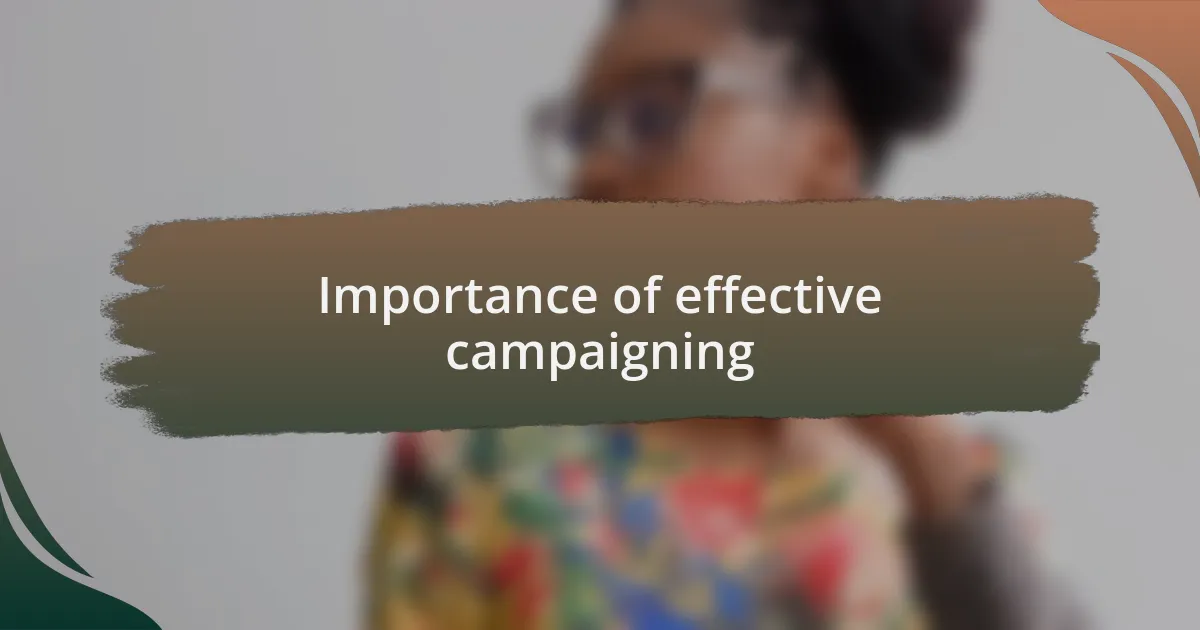
Importance of effective campaigning
Effective campaigning plays a pivotal role in raising awareness about women’s health issues. I recall a powerful campaign focused on maternal health that not only informed women about potential complications during pregnancy but also empowered them to seek immediate medical assistance when necessary. This kind of outreach can dramatically change attitudes, leading to healthier outcomes for mothers and their babies.
Interestingly, effective campaigning also helps to foster community solidarity. During a local initiative I participated in, women shared their personal health stories, creating a ripple effect that encouraged others to voice their struggles. When campaigns resonate on a personal level, they can inspire collective action, reinforcing the idea that no one has to navigate their health challenges alone.
Moreover, the impact of clear messaging cannot be underestimated. I remember watching a campaign video that eloquently addressed mental health stigma among women, making me reflect: how many women are silently suffering due to societal pressures? When campaigns effectively communicate their messages, they not only educate but also instigate conversations that can lead to significant shifts in public perception and policy. This reflects the profound potential of campaigning as a tool for transformation.
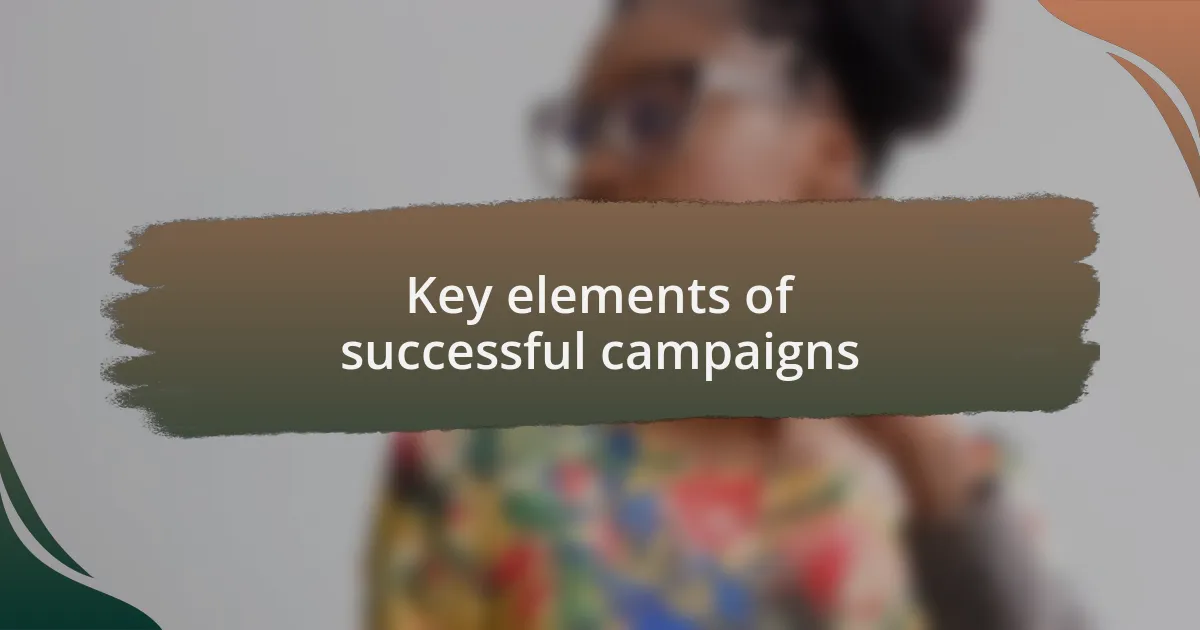
Key elements of successful campaigns
Successful campaigns hinge on strong messaging. I remember a campaign that utilized relatable narratives to connect with its audience. When the message feels personal, it captivates and compels the audience to engage more deeply. It makes you wonder, how can a single story spark such overwhelming support?
Another key element is strategic partnerships. Collaborating with local community organizations can amplify the outreach of a campaign. From my experience, when I teamed up with a local women’s center, we were able to tap into existing trust and relationships. This synergy not only expanded our reach but also enriched the campaign with diverse perspectives, creating a more impactful experience for everyone involved.
Finally, consistent monitoring and evaluation are crucial. Reflecting on a previous campaign, we found that regular feedback helped us adjust our strategies on the fly. This adaptability ensured that we remained responsive to the needs and concerns of the community. Have you ever noticed how campaigns that evolve over time tend to resonate more? It’s a reminder that understanding our audience is an ongoing journey, not a one-time task.
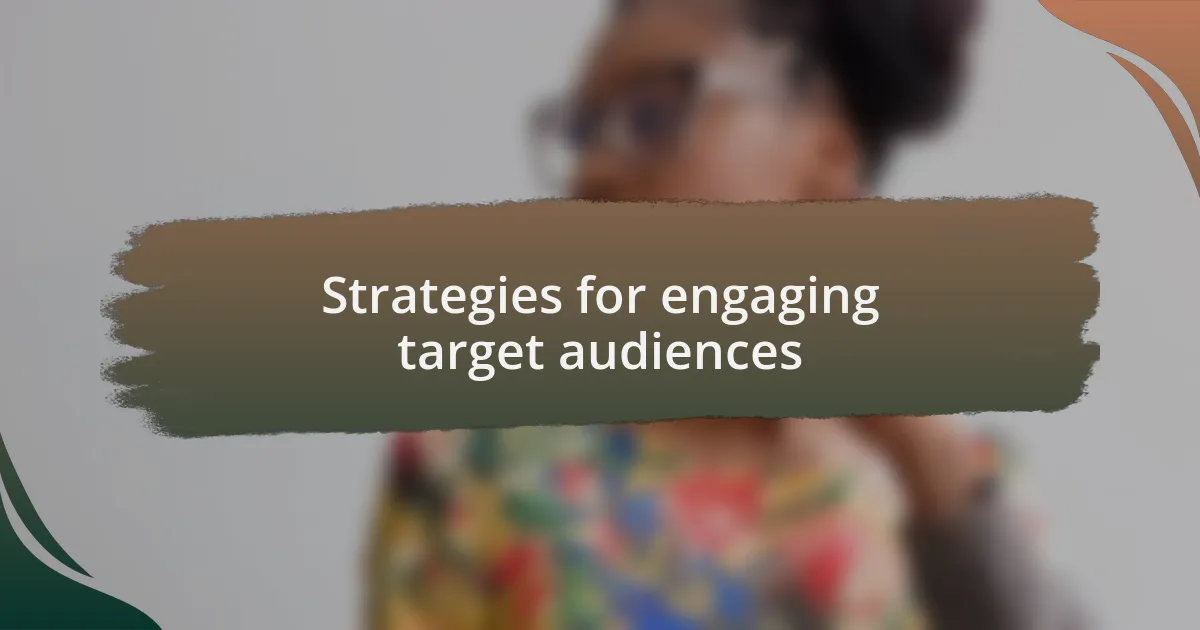
Strategies for engaging target audiences
Engaging target audiences requires a genuine approach that goes beyond traditional messaging. In my experience, hosting community events creates a space where individuals can share their stories and concerns in a safe environment. I once participated in a panel discussion focusing on women’s health issues, and the candid conversations that emerged not only educated attendees but also fostered a sense of belonging. Have you ever left an event feeling truly heard? That powerful connection often transforms passive listeners into active advocates.
Another effective strategy is leveraging social media platforms for real-time engagement. I remember launching a campaign that utilized Instagram stories, allowing participants to share their health journeys through interactive polls and Q&A sessions. This approach not only made the conversation more dynamic but also allowed us to collect immediate feedback. Isn’t it fascinating how technology can facilitate authentic connections in ways that were unimaginable a decade ago?
Additionally, tailoring content to reflect the unique interests of your audience can significantly enhance engagement. During a campaign focused on reproductive health, I discovered that specific topics resonated more with younger audiences. By creating targeted messaging around those issues, we increased participation and created a dialogue that felt relevant and timely. This experience taught me that understanding your audience’s needs is essential for fostering meaningful engagement. What strategies have you found effective in connecting with diverse groups?
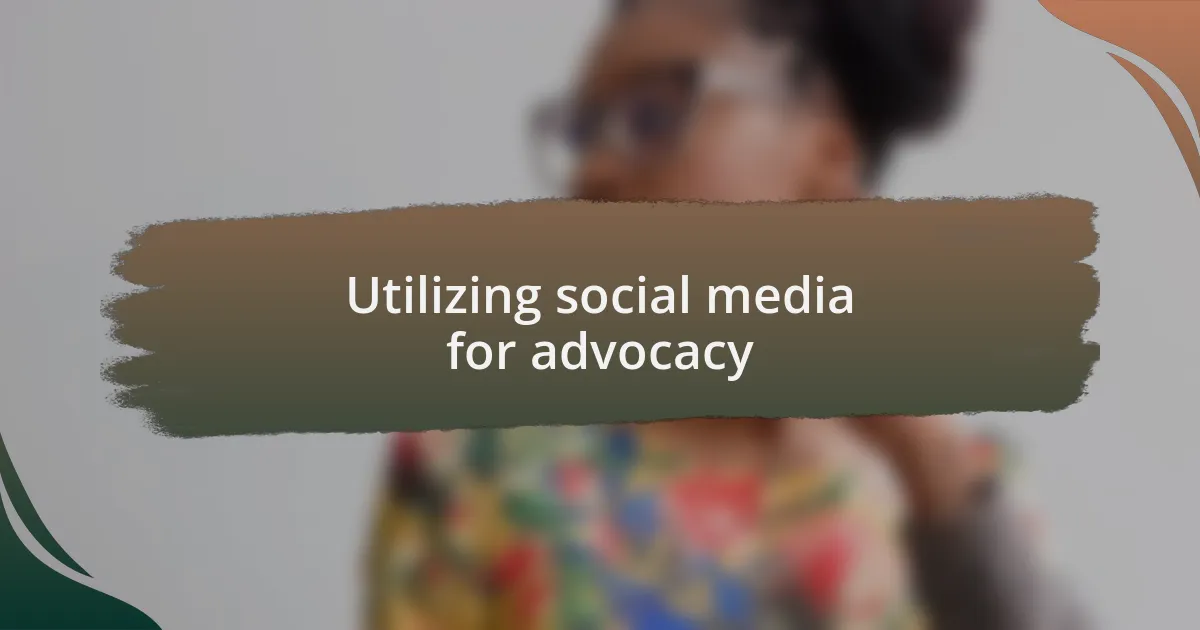
Utilizing social media for advocacy
Utilizing social media for advocacy has become an invaluable asset in today’s digital landscape. I recall launching a campaign on Twitter, where we used hashtags to create a unifying thread for conversations around mental health in women. The way individuals shared their stories, often filled with vulnerability and strength, reminded me of the importance of creating a virtual community that fosters support. Have you ever felt empowered by simply reading someone else’s experience?
Engagement on these platforms is not just about broadcasting messages; it’s about building relationships. When I posted a video featuring testimonials from women volunteers, I was surprised by how many viewers reached out to share their own narratives in the comments. This back-and-forth dialogue sparked a deeper level of connection, proving that social media can be more than just a channel for information—it can be a catalyst for change. What if we all took a moment to share our own stories online?
Moreover, I find that using visuals—like infographics or emotional images—on platforms like Instagram can dramatically enhance the impact of advocacy messages. I remember creating an infographic that illustrated statistics on women’s health issues, paired with real quotes from impacted individuals. The response was immediate and overwhelmingly positive, as it allowed followers to digest complex information quickly, inviting them to engage further. Isn’t it remarkable how a single image can spark awareness and inspire action?
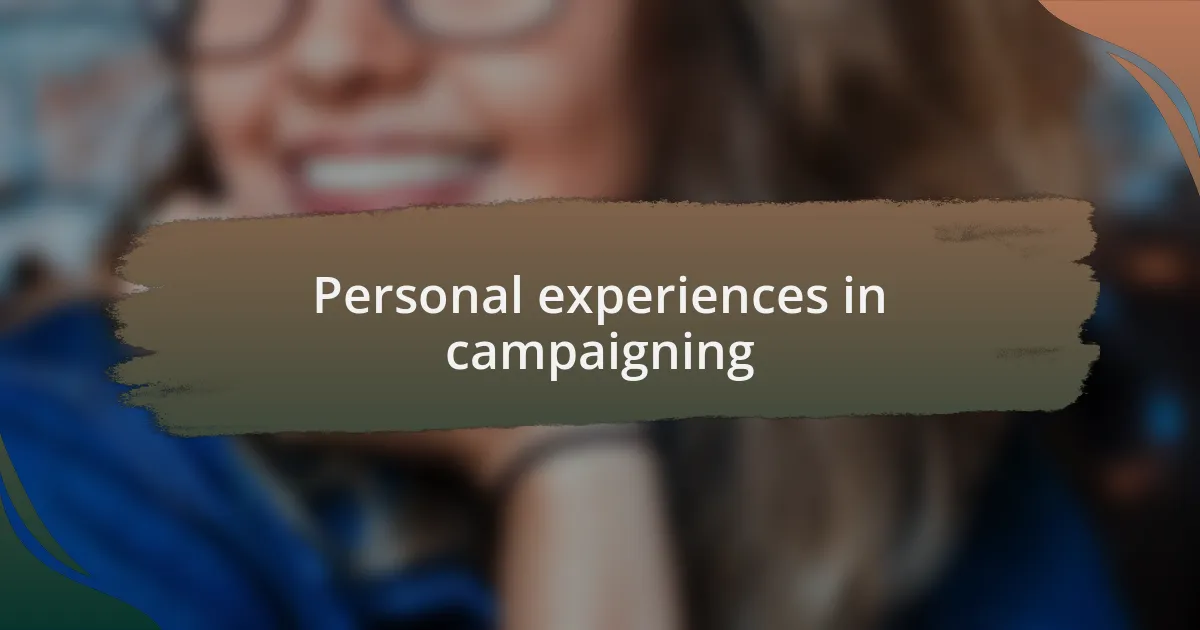
Personal experiences in campaigning
When I first got involved in campaigning, I felt both excited and intimidated. I remember attending a local health fair where I set up a booth to advocate for women’s health screening. Engaging with attendees face-to-face was transformative; hearing their stories about early detection and survival made me realize the profound impact of awareness. Have you ever experienced that moment when a conversation shifts your perspective entirely?
There was one campaign where I collaborated with local artists to create a mural dedicated to women’s resilience in health struggles. As we painted, I witnessed how passersby stopped to share their stories, some even tearfully expressing their gratitude for public acknowledgement. This experience reinforced my belief that art can be a powerful vehicle for advocacy, breaking down barriers and inviting community dialogue. Isn’t it incredible how art can evoke such raw emotion and connection?
During another initiative, I organized workshops to educate women about mental health strategies. I initially worried whether the turnout would meet expectations, but I was overwhelmed by the attendance and participation. Each shared experience in those workshops illustrated the beauty of vulnerability and the strength found in collective healing. Don’t you think that when we come together, our individual struggles seem a little lighter?
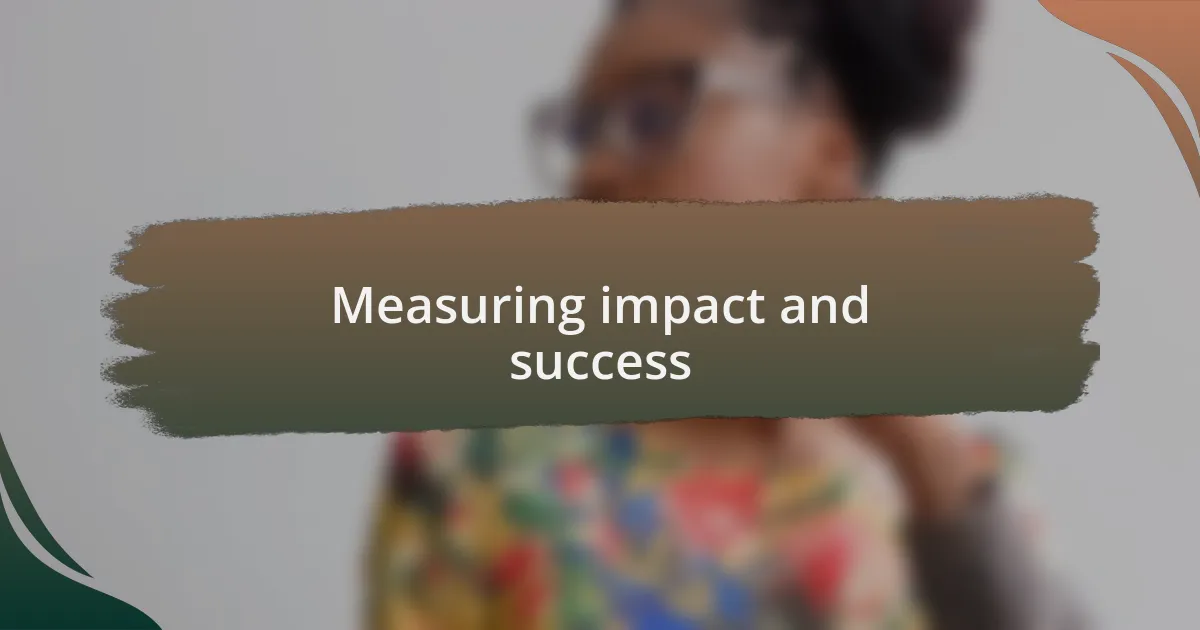
Measuring impact and success
Measuring the impact of a campaign goes beyond tallying numbers; it requires a deep understanding of how those numbers translate into real lives affected. I recall a fundraiser where we aimed to increase awareness about breast cancer screenings. After analyzing post-event surveys, I was surprised to see an uptick in attendees scheduling their screenings. Isn’t it heartening to know that our efforts directly influenced proactive health decisions?
One of the most enlightening aspects of measuring success is the emotional feedback we receive. During one campaign, we implemented follow-up interviews with women who participated in our programs. I was touched to hear how our workshops not only provided vital information but also fostered a supportive community. How do you quantify the power of connection that leads someone to prioritize their health?
While quantitative metrics like attendance and funds raised are essential, qualitative insights often reveal a campaign’s true impact. I remember a time when a participant spoke about how our discussions on mental health encouraged her to seek therapy. This story illustrated that success isn’t just in statistics but also in the lives we touch and the changes we inspire within our community. Isn’t that what truly defines success in advocacy?